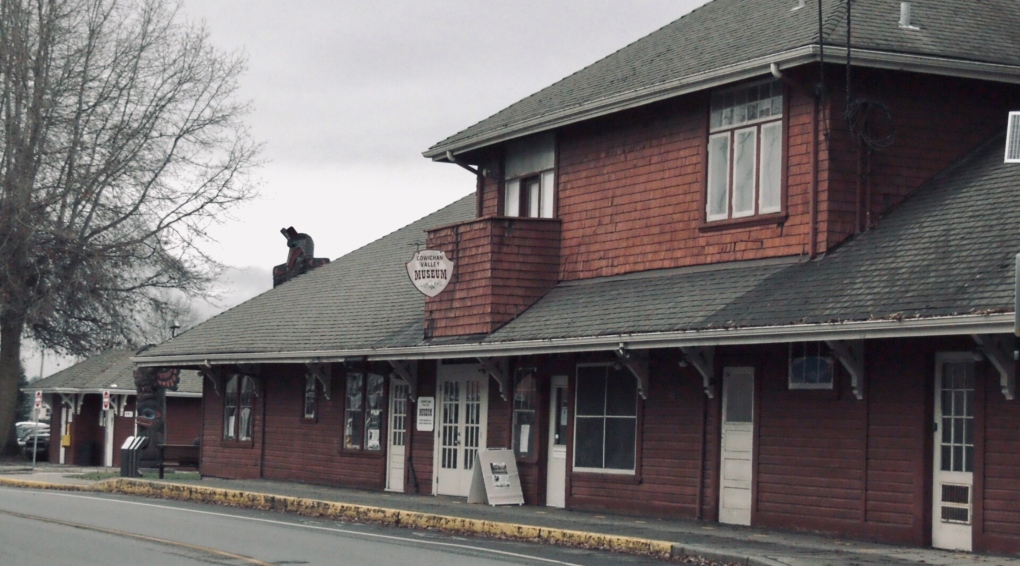Duncan train station a finalist in online competition for restoration funds
 The Duncan Train Station is a top 10 finalist in a national online competition that will award $50,000 to a historical building for restoration. (CTV)
The Duncan Train Station is a top 10 finalist in a national online competition that will award $50,000 to a historical building for restoration. (CTV)
The Duncan train station is a top 10 finalist in a national online competition that will award $50,000 to a historical building for restoration.
The heritage building is the only entry on Vancouver Island and is one of four in B.C. to be a finalist.
The competition is called the Next Great Save and is put on by the National Trust of Canada. The mission in this competition is to save heritage buildings in Canada by reducing their carbon footprint.
The Cowichan Historical Society operates the station, which also houses the Cowichan Valley Museum and Archives, says if it wins the competition, it will use the funds to make the building more energy efficient.
The building's heating system desperately needs to be replaced with energy-efficient electric heat pumps. By doing so, the society says it would reduce its carbon emissions by 24 per cent and its heating costs by 70 per cent. In the winter months, the building's current hydro bill is more than $900 per month.
The society would also like to increase the building’s insulation and replace the windows with custom-made ones that are energy efficient and also meet historical standards.
Built in 1912, the train station was originally proposed to be farther north on the island, but the community at the time rallied to keep in Duncan. Now, 111 years later, it still stands in the same location.
“It’s very unique,” says Keith Price, a director with the Cowichan Historical Society.
“There are some others in Canada that are being saved or in the process, but they have been moved from their original locations.”
Other renovations – such as replacing shingles, gutters and fascia boards, repointing the original chimneys, repainting the exterior, and fixing drainage issues – all need to be addressed as well.
The society has plans to restore the whole building over the next 10 to 15 years, at an estimated cost of $300,000. That estimate was made before the COVID-19 pandemic, however, and the society believes the total cost has increased since then.
People can vote once per day on the national trust website until the competition ends on Feb. 22.
CTVNews.ca Top Stories

BREAKING Israel attacks Iran, Reuters sources say; drones reported over Isfahan
Israel has attacked Iran, three people familiar with the matter told Reuters, as Iranian state media reported early on Friday that its forces had destroyed drones, days after Iran launched a retaliatory drone strike on Israel.
American millionaire Jonathan Lehrer denied bail after being charged with killing Canadian couple
American millionaire Jonathan Lehrer, one of two men charged in the killings of a Canadian couple in Dominica, has been denied bail.
Nearly half of China's major cities are sinking, researchers say
Nearly half of China's major cities are suffering 'moderate to severe' levels of subsidence, putting millions at risk of flooding especially as sea levels rise.
Prince Harry formally confirms he is now a U.S. resident
Prince Harry, the son of King Charles III and fifth in line to the British throne, has formally confirmed he is now a U.S. resident.
Judge says 'no evidence fully supports' murder case against Umar Zameer as jury starts deliberations
The judge presiding over the trial of a man accused of fatally running over a Toronto police officer is telling jurors the possible verdicts they may reach based on the evidence in the case.
Health Canada to change sperm donor screening rules for men who have sex with men
Health Canada will change its longstanding policy restricting gay and bisexual men from donating to sperm banks in Canada, CTV News has learned. The federal health agency has adopted a revised directive removing the ban on gay, bisexual and other men who have sex with men, effective May 8.
Colin Jost names one celebrity who is great at hosting 'Saturday Night Live'
Colin Jost, who co-anchors Saturday Night Live's 'Weekend Update,' revealed who he thinks is one of the best hosts on the show.
Sports columnist apologizes for 'oafish' comments directed at Caitlin Clark. The controversy isn't over
A male columnist has apologized for a cringeworthy moment during former University of Iowa superstar and college basketball's highest scorer Caitlin Clark's first news conference as an Indiana Fever player.
'Shopaholic' author Sophie Kinsella reveals brain cancer diagnosis
Sophie Kinsella, the best-selling author behind the 'Shopaholic' book series, has revealed that she is receiving treatment for brain cancer.
































